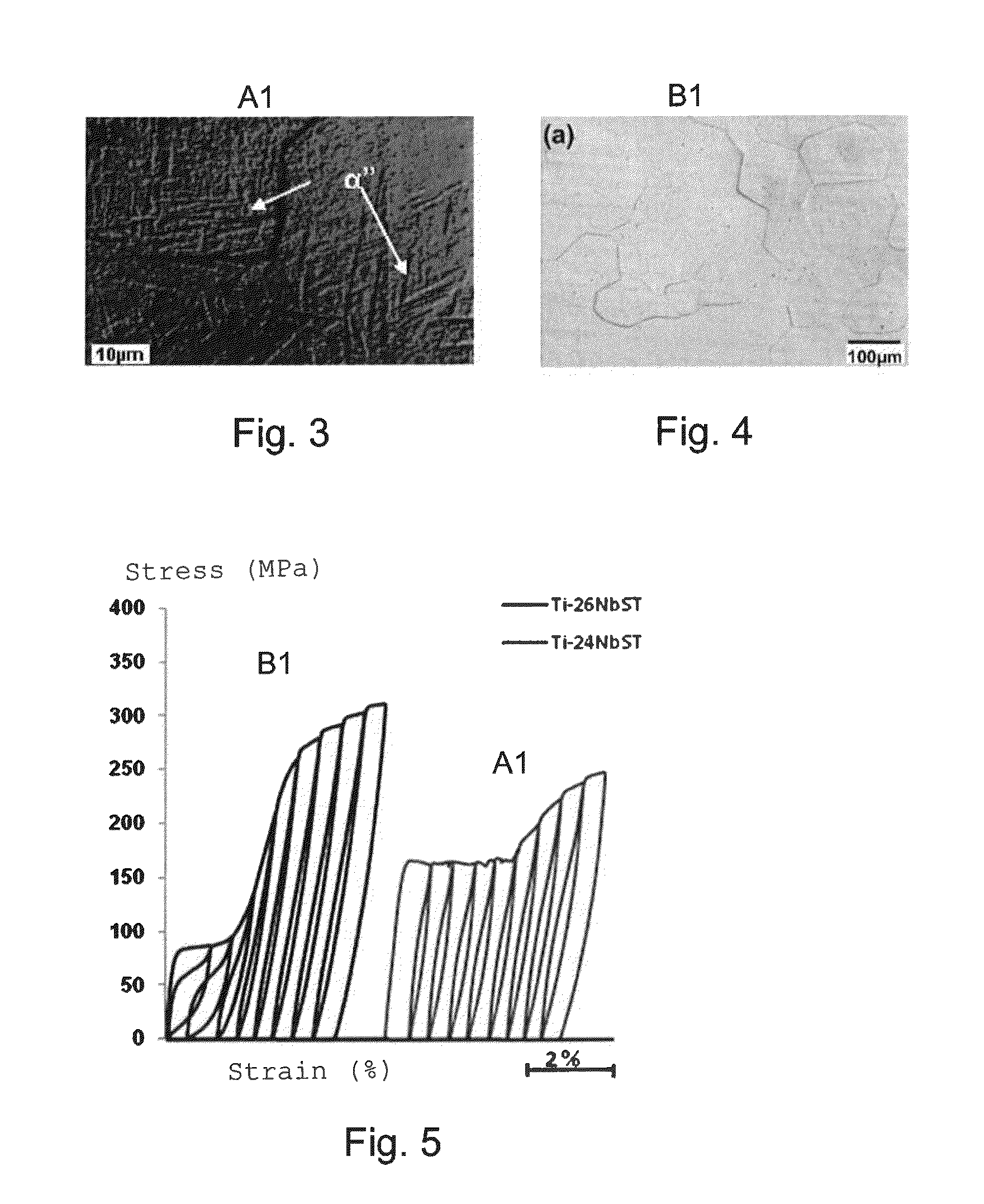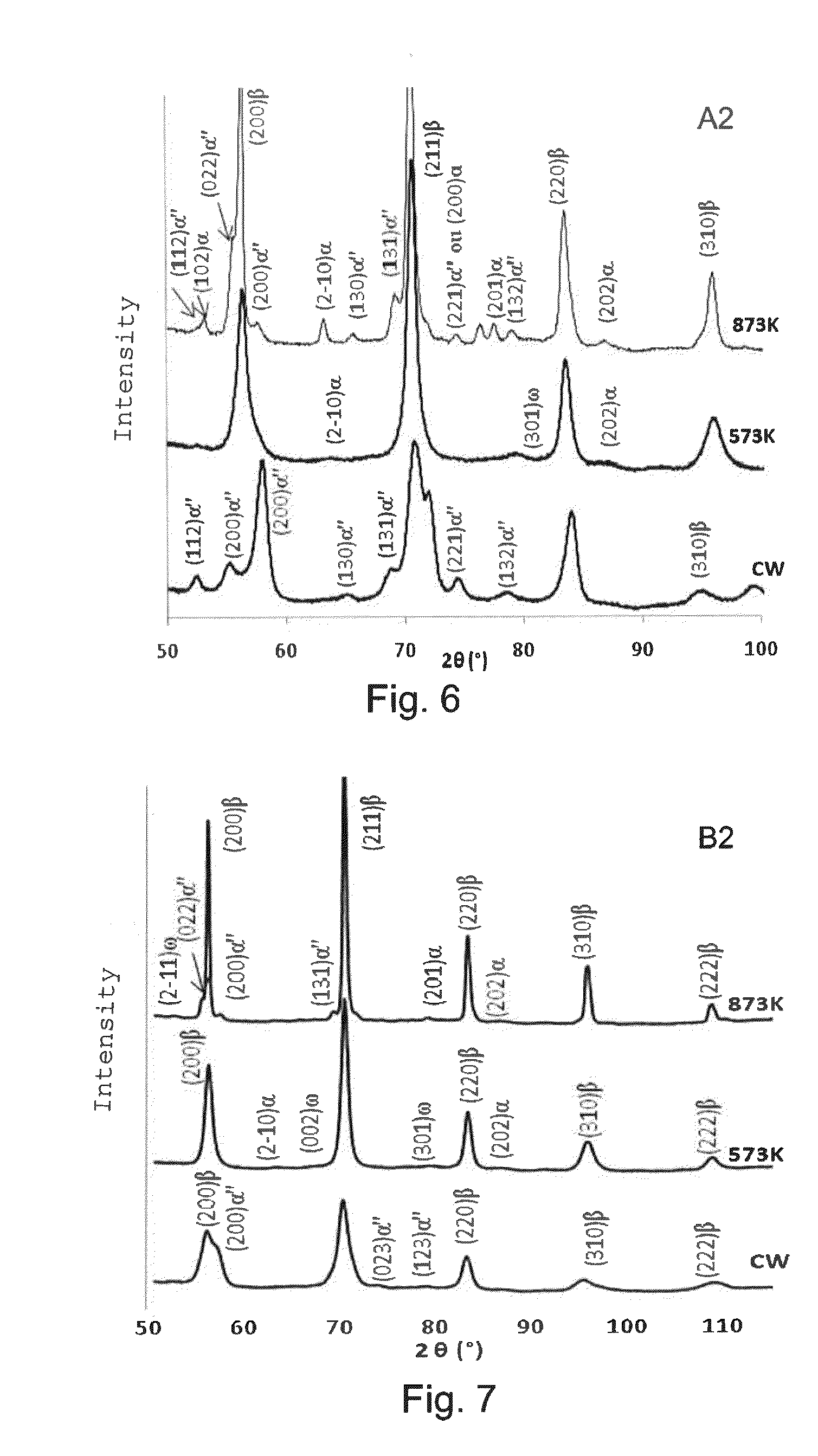Method for the thermomechanical treatment of a titanium alloy, and resulting alloy and prosthesis
a titanium alloy and thermomechanical treatment technology, applied in the field of titanium alloy thermomechanical treatment, can solve the problems of incorrect anchoring of the prosthesis, bone deterioration at the interface with the prosthesis, etc., and achieve the effects of good biocompatibility, low young's modulus, and high mechanical strength
- Summary
- Abstract
- Description
- Claims
- Application Information
AI Technical Summary
Benefits of technology
Problems solved by technology
Method used
Image
Examples
example 1
[0048]Two samples are prepared according to the process described above, sample A1 including 24% niobium in atomic proportion, the remainder being titanium, and sample B1 including 26% niobium, the rest also being titanium.
[0049]An analysis by X-ray diffraction is shown on FIGS. 1 and 2 respectively. FIG. 1 concerns sample A1 and clearly shows peaks which correspond to an α″ martensite phase of orthorhombic structure, whereas sample B1, on FIG. 2, shows only peaks corresponding to a unique centred cubic β phase. FIG. 3 shows an optical microscope view of sample A1, on which α″ martensite variants can be clearly seen. Two dominant characteristic morphologies are seen with the electronic transmission microscope, that is a triangular shape and a V-shape. FIG. 4, concerning sample B1, shows that the sample consists of phase β equiaxial grains of a size of around 100 μm.
[0050]Mechanical characterisation tests were conducted by doing tension-release cycles with constant strain increments....
example 2
[0051]Samples from the process described in example 1 are submitted to a severe cold rolling applying a true strain greater than 3. Then they are submitted to a short ageing heat treatment of 10 minutes terminated by a water quench. Two temperature levels were explored: 573K and 873K (300 and 600° C.). FIG. 6 shows three X-ray diffraction diagrams for a sample A1 rolled and not aged (A2 CW), a sample Al rolled and aged at 573K (A2 573K) and a sample A1 rolled and aged at 873K (A2 873K). Likewise, FIG. 7 shows three X-ray diffraction diagrams for a sample B1 rolled and not aged (B2 CW), a sample B1 rolled and aged at 573K (B2 573K) and a sample B1 rolled and aged at 873K (B2 873K). The analysis of sample B2 CW shows the presence of β phase and α″ martensite induced by the strain. For sample A2 573K, it can be seen that the inverse transformation of the martensite into austenite is almost complete, maintaining a high dislocation density. Traces of w phase and α phase appear by the dec...
example 4
[0059]Samples including 0.5% oxygen or 0.5% nitrogen were prepared with 24% niobium in atomic weight according to the process described for example 1. These components have a betagenic effect, that is temperature Ms is lowered. These alloys have a β structure at ambient temperature, like sample B1. In comparison with sample B1, in the state after homogenisation treatment and quench, the mechanical strength is clearly improved, as shown by the results in table 1.
Young'sRecoverableMaximummodulusstrainstrengthElongationSampleCompositionStructure(GPa)(%)(MPa)(%)C1Ti—24Nb—0.5Oβ501.883022D1Ti—24Nb—0.5Nβ382.2568013B1Ti—26Nb—β55142025
PUM
| Property | Measurement | Unit |
|---|---|---|
| temperature | aaaaa | aaaaa |
| temperature | aaaaa | aaaaa |
| temperature | aaaaa | aaaaa |
Abstract
Description
Claims
Application Information
 Login to View More
Login to View More - R&D
- Intellectual Property
- Life Sciences
- Materials
- Tech Scout
- Unparalleled Data Quality
- Higher Quality Content
- 60% Fewer Hallucinations
Browse by: Latest US Patents, China's latest patents, Technical Efficacy Thesaurus, Application Domain, Technology Topic, Popular Technical Reports.
© 2025 PatSnap. All rights reserved.Legal|Privacy policy|Modern Slavery Act Transparency Statement|Sitemap|About US| Contact US: help@patsnap.com



